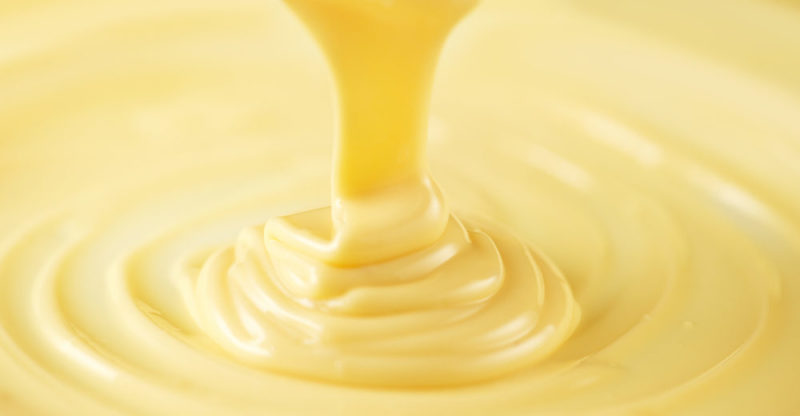We explain what colloids are and how this composite system is classified. Also, what are its characteristics and examples.
What are colloids?
Colloids (colloidal system, suspension or dispersion) are systems composed of two phases (continuous / fluid and dispersed). The dispersed phase is the one with the lowest proportion and the fluid or continuous phase is the one with the highest proportion.
Colloids and suspensions
 Colloids differ from chemical suspensions by the size of the particles : the particles of colloids cannot be seen with the naked eye, whereas those of chemical suspensions can.
Colloids differ from chemical suspensions by the size of the particles : the particles of colloids cannot be seen with the naked eye, whereas those of chemical suspensions can.On the other hand, when a colloid is left to stand, its phases do not separate and, on the contrary, the phases of a suspension do separate when the suspension is allowed to stand.
Characteristics of colloids
- Composition . Its composition includes particles of various sizes that can have intermediate properties between solution and suspension, and that tend to settle in a state of rest.
- Adsorption . Colloidal particles occupy a very large area. They have a great adsorption capacity (accumulation of a substance on a certain interfacial surface that forms a liquid or gaseous film on the surface of a body), through Van der Waals forces and interatomic bonds , that is, they can maintain atoms or molecules of other substances attached to its surface through these interactions.
- Electrophoresis . They have a migration of charged colloidal particles within an electric field, which adsorb ions on the surface (positive or negative), although the system itself is electrically neutral.
- Dialysis . They present dialysis, a movement of molecules and ions through porous membranes, which makes it possible to purify the colloidal system by eliminating impurities such as ions and molecules through dialytic membranes, made of animals or cellophane.
- Heterogeneity . Colloidal systems are heterogeneous, with particles of one or more components in both phases (dispersed and dispersant) and different sizes of these particles ranging from 10-2000 Å or less (in the case of the dispersing phase).
- Tyndall effect . They present a Tyndall effect, that is, a light beam becomes visible when passing through a colloidal system due to the multidirectional dispersion of light as it passes through this system.
- Brownian motion . The particles move haphazardly in the medium by the collision of the molecules with each other and with the medium, which can prevent them from settling and sedimenting.
Types of colloids
There are different types of colloids:
- Emulsions . They are colloidal dispersions of a liquid in another liquid with which they are immiscible. They are prepared by stirring the mixture or using a mill.
- Suns . The continuous phase is liquid. These colloidal systems can be lyophobic (with little attraction between the dispersed and continuous phases) or lyophilic (with strong attraction between the dispersed and continuous phases). Lyophobic sols coagulate or precipitate due to the presence of electrolytes or due to the elevation of their temperature .
- You aerosols . They are systems with liquid or solid particles subdivided and dispersed in a gas (dispersant phase).
- Gels . They are colloidal systems of higher viscosity.
- Foam . They have a liquid or gaseous dispersant phase, and a gaseous dispersed phase.
Examples according to their colloid type
 Some examples are:
Some examples are:
- Emulsion . Milk, mayonnaise, butter.
- Sun . Paint , milk of magnesia.
- Aerosol . Clouds.
- Gel . Jelly, gummies (sweets), jellies.
- Foam . Whipped cream.
Examples according to their composition
- Gaseous continuous phase:
- Dispersed phase (FD) gaseous . It's not possible.
- Liquid DF . Fog, haze.
- Solid FD . Smoke, ambient dust.
- Liquid continuous phase:
- FD fizzy . Shaving foam, milk cream.
- Liquid DF . Mayonnaise, creams.
- Solid FD . Paints, inks.
- Solid continuous phase:
- FD fizzy . Pumice stone, meringue.
- Liquid DF . Jelly.
- Solid FD . Ruby crystals.
The above content published at Collaborative Research Group is for informational and educational purposes only and has been developed by referring reliable sources and recommendations from technology experts. We do not have any contact with official entities nor do we intend to replace the information that they emit.
MA student of the TransAtlantic Masters program at UNC-Chapel Hill. Political Science with a focus on European Studies. Expressed ideas are open to revision. He not only covers Technical articles but also has skills in the fields of SEO, graphics, web development and coding. .
Leave a reply
Your email address will not be published. Required fields are marked *Recent post

Sport: What Is It, Types, Risks, Features, Characteristics and Examples

Dogs: Emergence, Features, Characteristics, Feeding and Breeds

Story: Definition, Elements, Structure, Features and Characteristics

